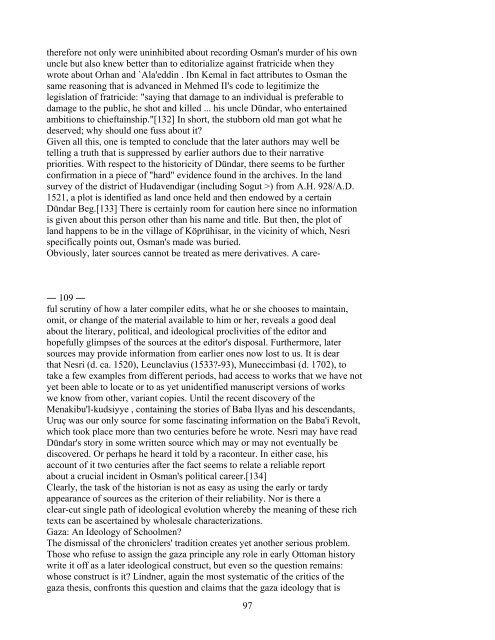Between Two Worlds Kafadar.pdf
Between Two Worlds Kafadar.pdf
Between Two Worlds Kafadar.pdf
Create successful ePaper yourself
Turn your PDF publications into a flip-book with our unique Google optimized e-Paper software.
therefore not only were uninhibited about recording Osman's murder of his own<br />
uncle but also knew better than to editorialize against fratricide when they<br />
wrote about Orhan and `Ala'eddin . Ibn Kemal in fact attributes to Osman the<br />
same reasoning that is advanced in Mehmed II's code to legitimize the<br />
legislation of fratricide: "saying that damage to an individual is preferable to<br />
damage to the public, he shot and killed ... his uncle Dündar, who entertained<br />
ambitions to chieftainship."[132] In short, the stubborn old man got what he<br />
deserved; why should one fuss about it?<br />
Given all this, one is tempted to conclude that the later authors may well be<br />
telling a truth that is suppressed by earlier authors due to their narrative<br />
priorities. With respect to the historicity of Dündar, there seems to be further<br />
confirmation in a piece of "hard" evidence found in the archives. In the land<br />
survey of the district of Hudavendigar (including Sogut >) from A.H. 928/A.D.<br />
1521, a plot is identified as land once held and then endowed by a certain<br />
Dündar Beg.[133] There is certainly room for caution here since no information<br />
is given about this person other than his name and title. But then, the plot of<br />
land happens to be in the village of Köprühisar, in the vicinity of which, Nesri<br />
specifically points out, Osman's made was buried.<br />
Obviously, later sources cannot be treated as mere derivatives. A care-<br />
― 109 ―<br />
ful scrutiny of how a later compiler edits, what he or she chooses to maintain,<br />
omit, or change of the material available to him or her, reveals a good deal<br />
about the literary, political, and ideological proclivities of the editor and<br />
hopefully glimpses of the sources at the editor's disposal. Furthermore, later<br />
sources may provide information from earlier ones now lost to us. It is dear<br />
that Nesri (d. ca. 1520), Leunclavius (1533?-93), Muneccimbasi (d. 1702), to<br />
take a few examples from different periods, had access to works that we have not<br />
yet been able to locate or to as yet unidentified manuscript versions of works<br />
we know from other, variant copies. Until the recent discovery of the<br />
Menakibu'l-kudsiyye , containing the stories of Baba Ilyas and his descendants,<br />
Uruç was our only source for some fascinating information on the Baba'i Revolt,<br />
which took place more than two centuries before he wrote. Nesri may have read<br />
Dündar's story in some written source which may or may not eventually be<br />
discovered. Or perhaps he heard it told by a raconteur. In either case, his<br />
account of it two centuries after the fact seems to relate a reliable report<br />
about a crucial incident in Osman's political career.[134]<br />
Clearly, the task of the historian is not as easy as using the early or tardy<br />
appearance of sources as the criterion of their reliability. Nor is there a<br />
clear-cut single path of ideological evolution whereby the meaning of these rich<br />
texts can be ascertained by wholesale characterizations.<br />
Gaza: An Ideology of Schoolmen?<br />
The dismissal of the chroniclers' tradition creates yet another serious problem.<br />
Those who refuse to assign the gaza principle any role in early Ottoman history<br />
write it off as a later ideological construct, but even so the question remains:<br />
whose construct is it? Lindner, again the most systematic of the critics of the<br />
gaza thesis, confronts this question and claims that the gaza ideology that is<br />
97













